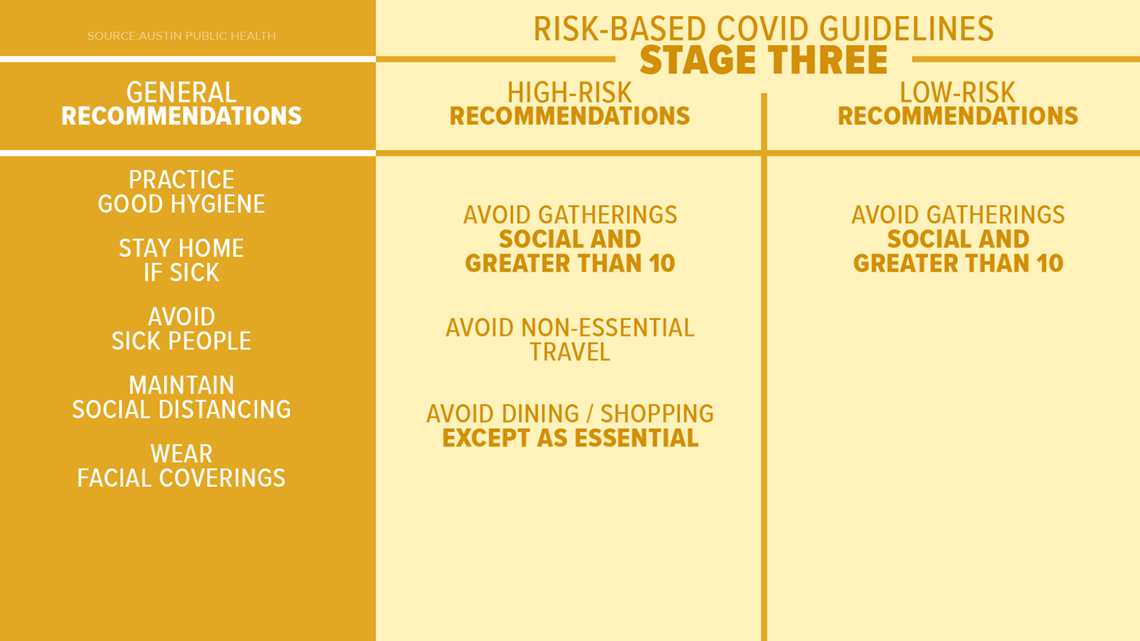AUSTIN, Texas — Austin-Travis County is moving into Stage 3 of Austin Public Health's (APH) COVID-19 risk-based guidelines for the first time since Nov. 18, 2020, local officials announced on Saturday morning.
"We are seeing more people getting vaccinated as supply to our area continues to increase," APH Director Stephanie Hayden-Howard said. "Our most vulnerable are becoming protected and we are hopeful that because of this our numbers will continue to decline, but it remains important to continue all prevention measures."
Hayden-Howard added that the community didn't get here by accident and local officials hope residents will continue to act responsibly.
"We know that our personal behavior to protect our loved ones and community played a large role. We hope with spring break and upcoming holidays near, we remember what got us to this stage and what it takes to continue to keep us safe," Hayden-Howard said.
Stage 3 recommendations include:
- Continue wearing a mask, social distancing and practicing good hygiene
- Higher-risk individuals (those over 65 and those who have chronic medical conditions) should avoid non-essential dining, shopping and travel
- Everyone should continue to avoid gatherings with social groups greater than 10
- Businesses and restaurants voluntarily operate at a reduced capacity of 50% to 75%


APH monitors the seven-day moving average of COVID-19 hospitalizations as the primary key indicator of the risk-based guidelines, but additional key indicators such as positivity rate, the doubling time of new cases and current ICU and ventilator patients are also monitored to determine what stage the area should be in. APH said all of these indicators are moving in the right direction, and modeling from the University of Texas also indicates an improving COVID-19 situation in the area.
"We have been successful in decreasing the risk of transmission in our community, but the virus that causes COVID-19 is still out there and there are variants continuing to appear,” said Dr. Mark Escott, the interim health authority for Austin-Travis County. "Today’s action represents a deliberate and measured step to relax guidance based upon the data and science. However, we must continue to mask, physically distance ourselves from others and wash our hands frequently. If we continue with these simple measures, we will continue to experience a decline in cases and will avoid a deadly third surge."
One year ago Saturday, Austin-Travis County reported its first two "presumptive positive" cases of the coronavirus.
In an interview on Friday, Dr. Escott said if we don't follow these guidelines he is afraid it could cause another surge.
"If everybody takes off the masking, if we have the increase introduction of variants, which we think certainly will happen," said Dr. Escott, "we are talking about a surge that starts in April and continues to escalate into May and June and continues into a portion of the summer and we don't want that."
APH said so far it has fully vaccinated about 45,000 people but has about 200,000 waiting for an appointment. Initially APH said it is choosing not to vaccinate group 1C after learning an increased allocation was not coming.
APH corrected that information with this statement:
"In addition to supporting the State’s efforts to advocate for more vaccine at the federal level, APH is working to prioritize the vaccine for more than 200,000 1A and 1B individuals in our system who have not yet received the vaccine, along with newly eligible education professionals, early childhood staff and 1C individuals.
"In the coming days, APH will make modifications to our registration platform to include the 1C population and allow us to prioritize based on 1A, 1B, and 1C status. Fortunately, since the state and federal government are successfully securing and allocating more vaccine, more providers across the Central Texas region are administering the vaccine to more Texans. To find a vaccine provider near you, visit: vaccinefinder.org."
Dr.Escott said the City and State are advocating for the federal government to use 2019 data to get accurate vaccine allocations.
"One of the challenges we have is the federal government is using 2018 census data as compared to 2019 census data, which leaves us with 1.5 million less people that's counted," said Dr. Escott.
PEOPLE ARE ALSO READING:

